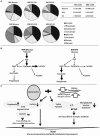Shaping the Metabolism of Intestinal Bacteroides Population through Diet to Improve Human Health
- PMID: 28326076
- PMCID: PMC5339271
- DOI: 10.3389/fmicb.2017.00376
Shaping the Metabolism of Intestinal Bacteroides Population through Diet to Improve Human Health
Keywords: Bacteroides; branched-chain amino acids; diet; human metabolism; intestinal microbiota; propionate; short chain fatty acids.
Figures

Similar articles
-
Intestinal Short Chain Fatty Acids and their Link with Diet and Human Health.Front Microbiol. 2016 Feb 17;7:185. doi: 10.3389/fmicb.2016.00185. eCollection 2016. Front Microbiol. 2016. PMID: 26925050 Free PMC article. Review.
-
In vitro characterization of the impact of selected dietary fibers on fecal microbiota composition and short chain fatty acid production.Anaerobe. 2013 Oct;23:74-81. doi: 10.1016/j.anaerobe.2013.06.012. Epub 2013 Jul 4. Anaerobe. 2013. PMID: 23831725
-
Melatonin reprogramming of gut microbiota improves lipid dysmetabolism in high-fat diet-fed mice.J Pineal Res. 2018 Nov;65(4):e12524. doi: 10.1111/jpi.12524. Epub 2018 Oct 12. J Pineal Res. 2018. PMID: 30230594
-
Antibiotic Exposure Has Sex-Dependent Effects on the Gut Microbiota and Metabolism of Short-Chain Fatty Acids and Amino Acids in Mice.mSystems. 2019 Jun 4;4(4):e00048-19. doi: 10.1128/mSystems.00048-19. mSystems. 2019. PMID: 31164448 Free PMC article.
-
Physiological Role of Gut Microbiota for Maintaining Human Health.Digestion. 2016;93(3):176-81. doi: 10.1159/000444066. Epub 2016 Feb 9. Digestion. 2016. PMID: 26859303 Review.
Cited by
-
The effect of dietary supplementation of Lycium barbarum leaves on the growth performance, organ indexes and intestinal microflora of rats.Front Vet Sci. 2024 Jul 31;11:1416793. doi: 10.3389/fvets.2024.1416793. eCollection 2024. Front Vet Sci. 2024. PMID: 39144075 Free PMC article.
-
Rett Syndrome and Other Neurodevelopmental Disorders Share Common Changes in Gut Microbial Community: A Descriptive Review.Int J Mol Sci. 2019 Aug 26;20(17):4160. doi: 10.3390/ijms20174160. Int J Mol Sci. 2019. PMID: 31454888 Free PMC article. Review.
-
Modifications in the Intestinal Functionality, Morphology and Microbiome Following Intra-Amniotic Administration (Gallus gallus) of Grape (Vitis vinifera) Stilbenes (Resveratrol and Pterostilbene).Nutrients. 2021 Sep 18;13(9):3247. doi: 10.3390/nu13093247. Nutrients. 2021. PMID: 34579124 Free PMC article.
-
Evaluating the prebiotic effect of oligosaccharides on gut microbiome wellness using in vitro fecal fermentation.NPJ Sci Food. 2023 May 9;7(1):18. doi: 10.1038/s41538-023-00195-1. NPJ Sci Food. 2023. PMID: 37160919 Free PMC article.
-
Segatella clades adopt distinct roles within a single individual's gut.NPJ Biofilms Microbiomes. 2024 Oct 27;10(1):114. doi: 10.1038/s41522-024-00590-w. NPJ Biofilms Microbiomes. 2024. PMID: 39465298 Free PMC article.
References
-
- Chambers E. S., Viardot A., Psichas A., Morrison D. J., Murphy K. G., Zac-Varghese S. E., et al. (2015). Effects of targeted delivery of propionate to the human colon on appetite regulation, body weight maintenance and adiposity in overweight adults. Gut 11, 1744–1754. 10.1136/gutjnl-2014-307913 - DOI - PMC - PubMed
LinkOut - more resources
Full Text Sources
Other Literature Sources

